On a quiet morning last December, Dionna Williams and Jason Rice wrapped up in warm clothes and readied themselves to “cross the border”.
No passports were required for this ride. Williams, a customer service representative, and Rice, a nursing assistant, both 33, were taking advantage of the holiday lull to go thrifting. Thinking nothing much of the journey they were about to undertake, Rice got into his car with Williams and tapped “Grosse Pointe” into his GPS.
The couple was headed towards a collection of suburbs surrounding the city of Detroit. But Detroit and Grosse Pointe could not be more different, and driving from one to the other feels like crossing into a different world – from urban devastation to suburban bliss in a matter of minutes. As a result, locals often refer to the act of exiting or entering Detroit as crossing the border.
Back in the car, Williams and Rice followed their driving instructions. But riding east along Kercheval Avenue, they suddenly reached a block in the road. Rice parked, and the pair got out to investigate; their electronic map had clearly missed a memo.
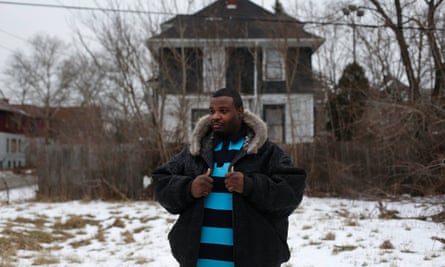
There, in the middle of the road, at the very point where Detroit morphs into Grosse Pointe Park, was a large, opulently decorated Christmas tree. Next to it, a collection of just over half a dozen smaller trees stood, taking up the rest of the width of the street.
The street had been sectioned off. They could not drive through. “We’d heard about it on the news, but it’s something else to see it in real life,” Rice said with some bewilderment. “To me it says: ‘Detroiters stay out! Don’t come in. You are not welcome here,’” Williams said.
The couple may not have been crossing international boundaries, but they did try to cross the increasingly visible line dividing Detroit and its collection of suburbs – one of the most shocking in America.
What they were witnessing for the first time was the latest installation in a succession of barriers erected over the course of 2014 by Grosse Pointe Park at the very point where Kercheval Avenue, a formerly busy commercial thoroughfare, goes from Detroit into the more opulent suburb.
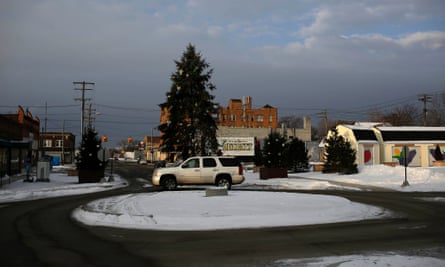
The first barrier to pop up in February 2014, as the region endured its snowiest winter on record, was a bulky mound of snow collected from the streets and strategically built in a perpendicular fashion, fully blocking traffic.
Call it dipping a toe in the water.
By June, months after the snow had melted, construction along the Kercheval Avenue border revealed itself to be a one-way roundabout, fully blocking traffic from Detroit and sending Grosse Pointe motorists straight back to where they came from.
A few days later, three farmers’ market sheds decorated with colorful paintings of strawberries and eggplants were placed, unannounced, at the end of the one-way roundabout, physically tracing the city limits in all their glorious quaintness, and once more taking up the full width of the street. The sheds stayed put for six months, holding market days and hosting Michigan fruit and veg producers twice a week.
At the end of the summer, when one vendor from Armada, Michigan, was asked about the divide her business location had come to represent, her answer came back as chirpy as the sheds she sat in front of: “We serve both Grosse Pointers and Detroiters.”
Sitting in front of the sheds on a slow Tuesday, she explained the venture could hardly be perceived as racist if it was open to both white and black customers. Separated, but equal, she seemed to suggest.
For some, the farmers’ market turned out to be the last straw. In August, a car coming from the Detroit side-slammed into the biggest shed in the middle of the night, leaving its side severely damaged. It was unclear whether the driver was making a statement of frustration, or whether he or she had simply not realized the road was now blocked.
Hastily repaired, the sheds stayed on, and were only partially displaced at the very end of the year, after Detroit’s mayor, Mike Duggan, went on a spontaneous televised rant declaring himself “tired of the lying” from Grosse Pointe Park’s administration, which had repeatedly promised – and failed – to remove the sheds.
After fully blocking access between Detroit and Grosse Pointe Park for a majority of 2014, Kercheval Avenue’s blockade was partially lifted in the early days of 2015. Cars can now come in from Detroit, but still cannot go back the other way. Meanwhile, leaks suggest plans are still under way to block the avenue with a larger and more permanent commercial structure.
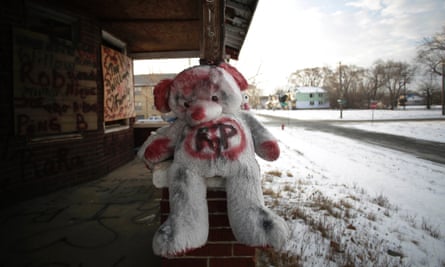
Grosse Pointe Park sits uncomfortably next to Detroit, torn between a waspy past and changing demographics. Today, it has the highest percentage of black residents of all the Grosse Pointes, with 10% of its population black and 85% white. As recently as 2000, it was not even 3% black.
But even if it is considerably more diverse than the other nearby Grosse Pointes (Grosse Pointe Farms is 95% white), it still stands in stark contrast to an almost 83% black Detroit. The difference is economic too: Grosse Pointe Park’s median household income is well over three times that of Detroit.
An informal door-to-door survey by Diverse GP, a group of residents seeking to address the rift between Detroit and Grosse Pointe, found that one in four Grosse Pointe Park residents was in favor of the sheds, one was indifferent, and the rest – roughly half – wanted the shed taken down.
For Diverse GP member Hans Barbe, a piano teacher who was raised in Grosse Pointe Park but now lives in Detroit, the market sheds were representative of an elephant in the room.“Frankly, growing up, I didn’t even question the strangeness of crossing Alter Road [one of the best-known roads separating Detroit and Grosse Pointe Park]. It’s like you go through some crazy inter-dimensional vortex,” Barbe said.
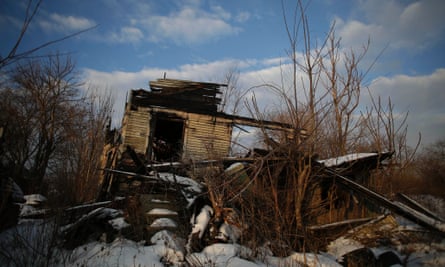
In fact, physical dividers between Detroit and the Grosse Pointes are nothing new. For decades, a stream, fences, walls and cul-de-sacs have all marked the exact geographical lines of the border, sectioning off suburban streets just as they meet Detroit. Their existence has mostly gone unquestioned. What raised eyebrows this time round was most probably the fact that Kercheval Avenue – unlike the other streets, which are residential and quiet – was a well-used commercial road.
Drive along the east side of Detroit and fields of overgrown, trashed lots and burned-down houses overwhelm the eye. Cars in driveways here, and black residents silently waiting for buses that take hours to arrive there, give hints at lives that continue to be lived amid the devastation.
Get to Alter Road, on the very edge of the city, and keep on driving east. Within minutes, you are thrown into an idyllic Grosse Pointe, where waterfront mansions and manicured lawns abound. Porches have a stately, colonial air and are often framed by large, white columns. A slim, white woman jogs along the streets with her glossy golden retriever. Depending on the season, you might even catch a few velvet bows decorating the streetlights.
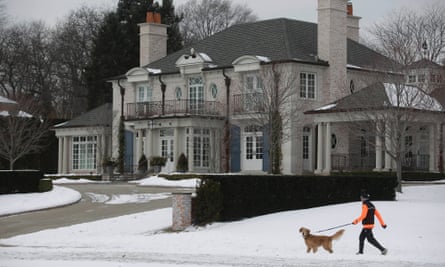
In Detroit, a campaign to get at least one streetlight per block working again in far-flung residential areas where homeowners describe their streets as war zones has finally gained some momentum.
David Goldberg, an assistant professor in Africana studies at Wayne State University who lives in east Detroit, ponders whether the barriers were a way of getting Detroiters who rely on the suburbs for basic amenities to stop shopping in those areas. “The idea is to get them on the highway and get them past Grosse Pointe and going somewhere else. To remove black visibility to make the area more attractive,” he said.
As black migration accelerated from the southern parts of the US to the north in the first half of the 20th century, white residents started cordoning themselves off in white neighborhoods and then, eventually, white suburbs.
The nature of low-interest federal housing loans starting in the 1930s, which excluded neighborhoods with even the faintest of black presence (a phenomenon known as redlining) created an economic incentive – above a simple racist one – to keep black families out of white neighborhoods. A black family arriving on a white block threatened the value of the entire block in a very real, federally sanctioned way.
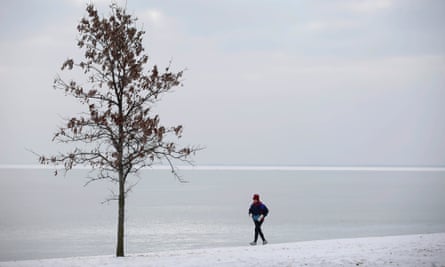
Well before the Detroit riots of 1967, which are often seen as one of the root causes of Detroit’s demise and white flight, white struggle to maintain white-only spaces was happening under the form of violent neighborhood vigilantes, as well as bureaucratic and federally sanctioned means, such as restrictive zoning in new suburbs.
The legacy of these practices lives on. For decades, in the second part of the 20th century, de facto redlining by the banks meant loans were difficult to come by for Detroiters. But during the subprime mortgage push of the 2000s, once-ignored Detroit residents were suddenly under siege with offers, and particularly at risk of predatory lending practices.
Two years ago, the American Civil Liberties Union helped bring a class-action lawsuit against Morgan Stanley for its collaboration with subprime lender New Century, which supplied the Manhattan-based bank with a steady stream of high-risk loans issued in communities of color across the nation. The pending lawsuit focuses on Detroit, which is deemed “particularly vulnerable”.
In many ways, the subprime mortgage crisis, which was explicitly and disproportionately destructive in communities of color, is a direct inheritor of the federally sanctioned redlining policies of the mid-20th century. And at least in terms of race transitioning into the colorblind discourse of economics, Kercheval Avenue’s barricade seems to be no exception either.
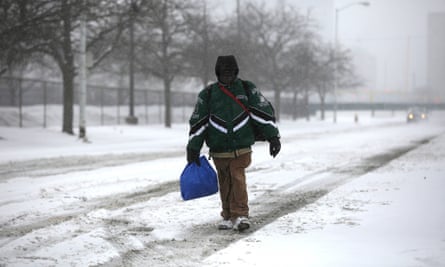
Dream Hampton, a film-maker, writer and cultural figure who has been in and out of Detroit most of her life, says: “I do not think there is a starker border anywhere in the country, quite frankly. And I have lived everywhere.”
In her view, beyond clear racial stereotypes, much of Grosse Pointe’s attitude to Detroit is based on a false premise of superiority along historical and economic lines. “Grosse Pointe is likely to say this is the money that built Detroit. Because of course it’s where the descendants of the great auto industry baron money – particularly the Fords – still live,” she says. “When in fact, it was the labor of the working-class Detroit that built Detroit. It’s the lion’s way of telling history.” And just in case anyone had forgotten, lions do not retreat before any.
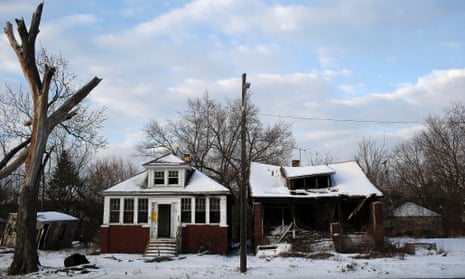
Comments (…)
Sign in or create your Guardian account to join the discussion